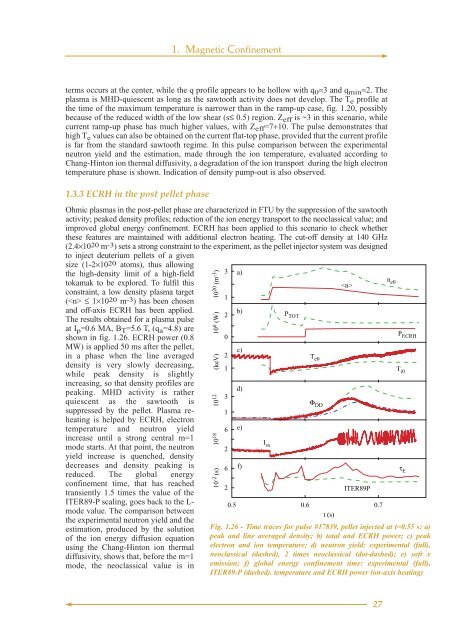2000 PROGRESS REPORT - ENEA - Fusione
2000 PROGRESS REPORT - ENEA - Fusione
2000 PROGRESS REPORT - ENEA - Fusione
You also want an ePaper? Increase the reach of your titles
YUMPU automatically turns print PDFs into web optimized ePapers that Google loves.
1. Magnetic Confinement<br />
terms occurs at the center, while the q profile appears to be hollow with q 0 ≈3 and q min ≈2. The<br />
plasma is MHD-quiescent as long as the sawtooth activity does not develop. The T e profile at<br />
the time of the maximum temperature is narrower than in the ramp-up case, fig. 1.20, possibly<br />
because of the reduced width of the low shear (s≤ 0.5) region. Z eff is ~3 in this scenario, while<br />
current ramp-up phase has much higher values, with Z eff =7÷10. The pulse demonstrates that<br />
high T e values can also be obtained on the current flat-top phase, provided that the current profile<br />
is far from the standard sawtooth regime. In this pulse comparison between the experimental<br />
neutron yield and the estimation, made through the ion temperature, evaluated according to<br />
Chang-Hinton ion thermal diffusivity, a degradation of the ion transport during the high electron<br />
temperature phase is shown. Indication of density pump-out is also observed.<br />
1.3.3 ECRH in the post pellet phase<br />
Ohmic plasmas in the post-pellet phase are characterized in FTU by the suppression of the sawtooth<br />
activity; peaked density profiles; reduction of the ion energy transport to the neoclassical value; and<br />
improved global energy confinement. ECRH has been applied to this scenario to check whether<br />
these features are maintained with additional electron heating. The cut-off density at 140 GHz<br />
(2.4×1020 m-3) sets a strong constraint to the experiment, as the pellet injector system was designed<br />
to inject deuterium pellets of a given<br />
size (1-2×1020 atoms), thus allowing<br />
the high-density limit of a high-field<br />
tokamak to be explored. To fulfil this<br />
constraint, a low density plasma target<br />
( ≤ 1×1020 m-3) has been chosen<br />
and off-axis ECRH has been applied.<br />
The results obtained for a plasma pulse<br />
at I p =0.6 MA, B T =5.6 T, (q a =4.8) are<br />
shown in fig. 1.26. ECRH power (0.8<br />
MW) is applied 50 ms after the pellet,<br />
in a phase when the line averaged<br />
density is very slowly decreasing,<br />
while peak density is slightly<br />
increasing, so that density profiles are<br />
peaking. MHD activity is rather<br />
quiescent as the sawtooth is<br />
suppressed by the pellet. Plasma reheating<br />
is helped by ECRH, electron<br />
temperature and neutron yield<br />
increase until a strong central m=1<br />
mode starts. At that point, the neutron<br />
yield increase is quenched, density<br />
decreases and density peaking is<br />
reduced. The global energy<br />
confinement time, that has reached<br />
transiently 1.5 times the value of the<br />
ITER89-P scaling, goes back to the L-<br />
mode value. The comparison between<br />
the experimental neutron yield and the<br />
estimation, produced by the solution<br />
of the ion energy diffusion equation<br />
using the Chang-Hinton ion thermal<br />
diffusivity, shows that, before the m=1<br />
mode, the neoclassical value is in<br />
10 20 (m -3 )<br />
10 6 (W)<br />
10 -2 (s) 10 18 10 12 (keV)<br />
3<br />
1<br />
2<br />
0<br />
2<br />
1<br />
3<br />
1<br />
6<br />
2<br />
6<br />
2<br />
a)<br />
b)<br />
c)<br />
d)<br />
e)<br />
f)<br />
I sx<br />
P TOT<br />
T e0<br />
Φ DD<br />
0.5 0.6 0.7<br />
t (s)<br />
Fig. 1.26 - Time traces for pulse #17839, pellet injected at t=0.55 s: a)<br />
peak and line averaged density; b) Fig. total 1.26 and ECRH power; c) peak<br />
electron and ion temperature; d) neutron yield: experimental (full),<br />
neoclassical (dashed), 2 times neoclassical (dot-dashed); e) soft x<br />
emission; f) global energy confinement time: experimental (full),<br />
ITER89-P (dashed). temperature and ECRH power (on-axis heating)<br />
<br />
ITER89P<br />
n e0<br />
P ECRH<br />
T i0<br />
τ E<br />
27













